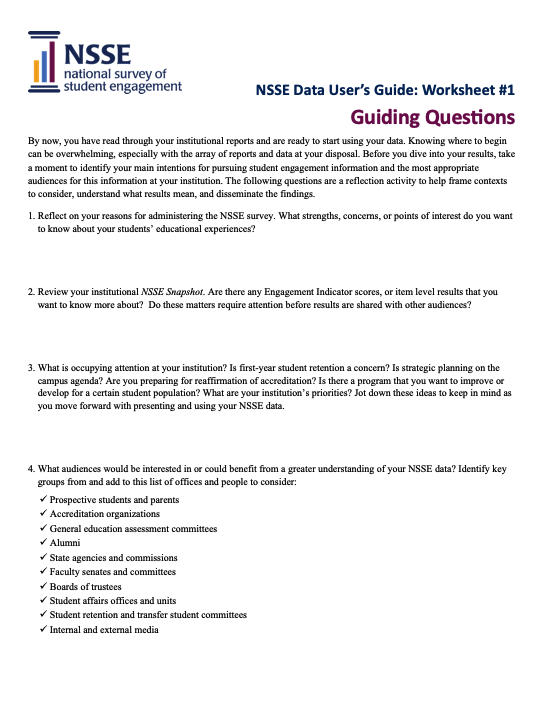
The improvement efforts of colleges and universities are most promising when they are based on evidence of the performance and experience of their students inside and outside the classroom. In addition, institutions’ evidence of their achievements and how they use data to inform improvement efforts is expected in response to demands for accountability and multiple pressures to increase student persistence and completion, support belonging and inclusion, and ensure high-quality learning for all students.
The National Survey of Student Engagement (NSSE) provides institutions with data and reports about critical dimensions of educational quality. Whether a campus is interested in assessing the amount of time and effort students put into their studies or the extent to which students utilize learning opportunities on campus, NSSE provides colleges and universities with diagnostic, actionable information that can inform efforts to improve the experience and outcomes of undergraduate education.
NSSE results can inform and structure conversations in efforts to enhance student learning and success across campus offices and projects including enrollment management and retention, marketing and communications, faculty development, learning support, and student housing. As an assessment instrument, NSSE can be used to identify both areas of strength as well as opportunities for growth to help make learning and the campus environment more cohesive with student needs and expectations.
Making NSSE data accessible and useful is key to engaging various campus audiences in identifying and analyzing institutional and program shortcomings and for developing targeted strategies for continuous improvement—critical steps in institutional growth and change.
A first step toward making use of results, is to consider the following prompts: a). who on your campus is most interested in student engagement results? b). What are the best ways to connect campus groups and committees with this information? and, c). What audiences could use this information in responding to campus challenges and opportunities?
Simply reporting NSSE results will not lead to action.
Getting good data, communicating what the data mean to invested parties, and using the data accordingly are critical steps in institutional change and achieving improved educational outcomes. The approach known as “double-loop learning” (Argyris & Schön, 1996) informs this work and involves the creation of “communities of practice” (Lave & Wenger, 1991)—practitioners engaged in dialogue to share experiences, identify problems, and learn with and from each other. It is through this kind of collaboration that community members can take ownership in institutional issues and work together to help institutions grow.
An early step in making the best use of NSSE data and reports is to revisit your institution’s rationale for participating in NSSE. What motivated your NSSE participation and what does the campus intend for the results? Knowing if your campus plans to use NSSE for accreditation, for routine assessment, or for student retention efforts, is important to determining where data are most relevant and to informing audiences eager to use the results.
Using NSSE data effectively also requires accurately interpreting the results and disseminating the interpretations along with the results to people who can do something about student engagement. Simply reporting NSSE results will not lead to action. Many institutions have found that sharing results at retreats, faculty workshops, first-year experience task force meetings, and other group gatherings is a productive way to stimulate interest and action.
The worksheets below can help you get started in your efforts to disseminate results via meetings, data workshops, and with committees and units that would benefit from student engagement data.
Select the links below to download MS Word versions of the worksheets, which can be customized for use on your campus.

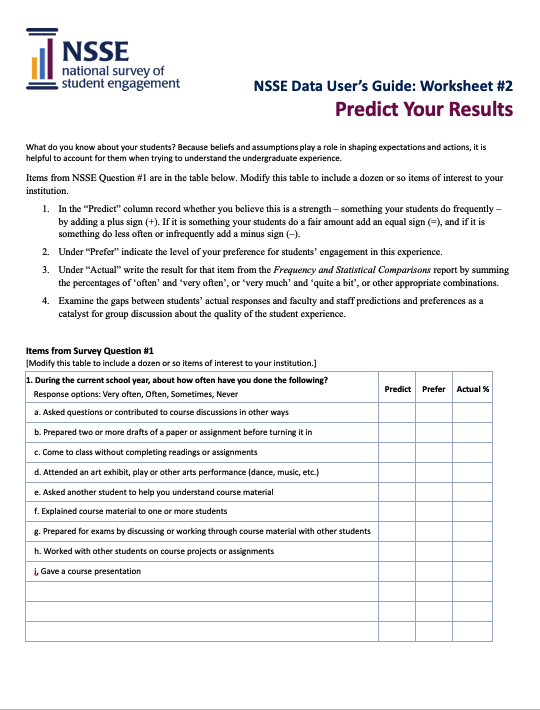
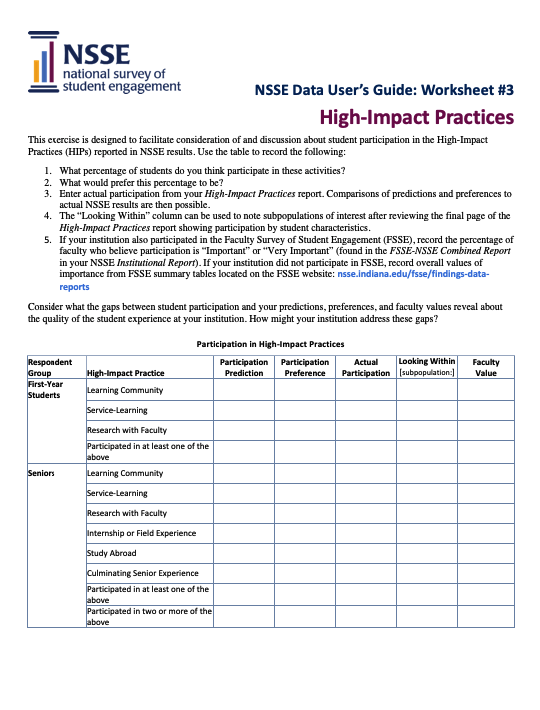
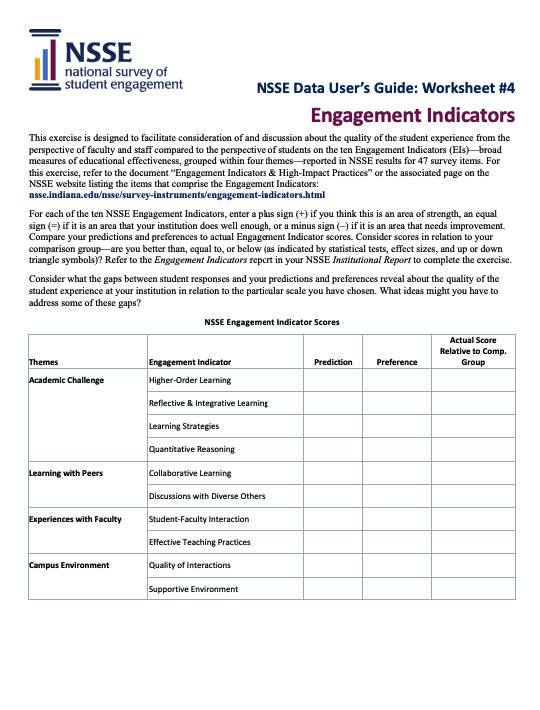
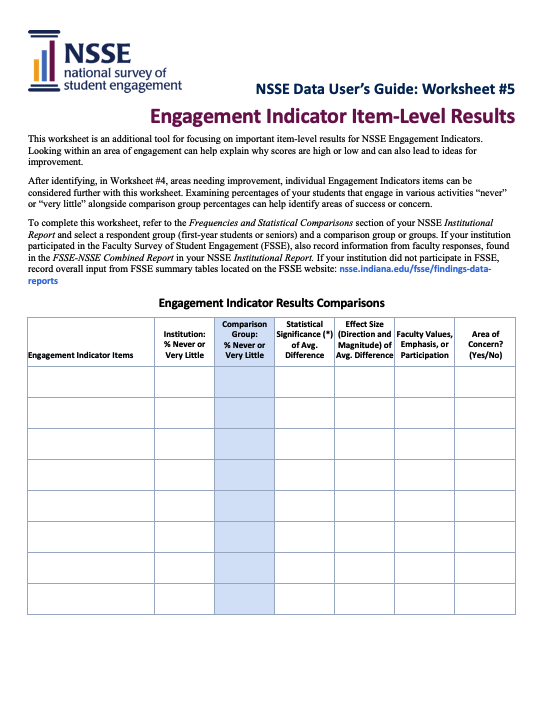

Fully participating in NSSE is more than administering the survey and receiving the results. Disseminating NSSE results to relevant audiences and committees across campus is arguably one of the most important steps of NSSE participation. Consider the many opportunities on your campus for sharing NSSE results, including:
The most effective uses of NSSE results take into consideration how dissemination is most likely to enhance education policy and practice. This involves identifying the audiences and contexts that surround the reporting activities.
To facilitate campus presentations of NSSE results, participating institutions are encouraged to use the customizable powerpoint provided in their Institutional Report package.
NSSE results make more sense when audiences have a basic understanding of the concept of student engagement. Research shows that engagement—the time and energy students devote to educationally purposeful activities—is the best single predictor of student learning and personal development. Higher levels of student engagement result from certain institutional practices, the best known set of which are the Seven Principles for Good Practice in Undergraduate Education (A. W. Chickering & F. Gamson [1987]. AAHE Bulletin, 39[7], 3–7):
Emphasizing good educational practice helps focus faculty, staff, students, and others on the tasks and activities associated with higher yields in desired student learning outcomes.
It is important to answer any questions that may arise regarding the validity and reliability of the NSSE survey before introducing the data and results to the workshop group. Staff may more readily accept the findings and consider changes to their practice if such questions are adequately addressed before the workshop begins.
The validity of self-reported data can be affected by the ability of respondents to provide accurate and truthful information in response to questions. Research shows that people generally tend to respond accurately on questions about their past behavior unless the questions are sensitive or make them uncomfortable. The validity of self-reported time estimates has also been examined. To provide survey respondents a frame of reference, NSSE items include specific periods of time to aid memory recall and to reduce the distortion that may occur when respondents remember events over time. Further research suggests that self-reported data are valid under five conditions, all of which NSSE was designed to satisfy:
The “halo effect”—which may account for satisfied students inflating performance, grades, or personal gains and efforts on surveys—appears to be fairly consistent across student populations. Thus, although what students report may differ somewhat from what they actually do, this effect does not appear to advantage or disadvantage one institution or student group compared with another.
Further information about research on self-reported data is in the Psychometric Portfolio. The portfolio provides a framework for presenting studies on the validity, reliability, and other indicators of quality of NSSE’s data, including analysis of data subsets defined by a variety of student and institutional characteristics.
When new NSSE users receive their results and reports, they may not know where to jump in, or they may first wonder, “What are we doing well?” or perhaps, "Do our results look better than ten years ago?". If you have many years of NSSE results, including from the early years (2000-2012), you may want to review your Benchmark Comparison report. This will give you comparative information to look inside and across your results. Second, look at the results to individual questions that comprise each benchmark. Specifically, it may be helpful to review the items with the greatest frequency of “Very often” against “Never” responses. If you are reviewing NSSE reports from 2013 and later, we recommend starting with your Snapshot report. Sharing this report with a wide campus audience may be a good first step, but providing campus units or groups with more tailored results or conducting interactive presentations using some of the worksheets in this user’s guide may help stimulate interest in additional results. The tips displayed in the box below may help your data dissemination initiatives.
Educational improvement is the primary goal in using NSSE. If your NSSE results are less than favorable this year, sharing the data with appropriate institutional stakeholders is even more important. If results are not shared, campus administrators may remain in the dark on crucial educational issues. For example, if NSSE results reveal that students are not interacting with academic advisors or faculty members as frequently as administrators had hoped, sharing the NSSE results is an important step in starting the change process.
For campuses that seek to exploit NSSE to its full potential, receiving NSSE’s detailed reports and student data files is not the end of a process. Rather, it signals the beginning of the next phase: using NSSE results. After data collection has concluded, the real work begins— making meaning from the results, identifying priorities for action, formulating concrete plans for improvement, and implementing those plans. At whatever point in this process your campus may be, we encourage you to take full advantage of all that NSSE provides.